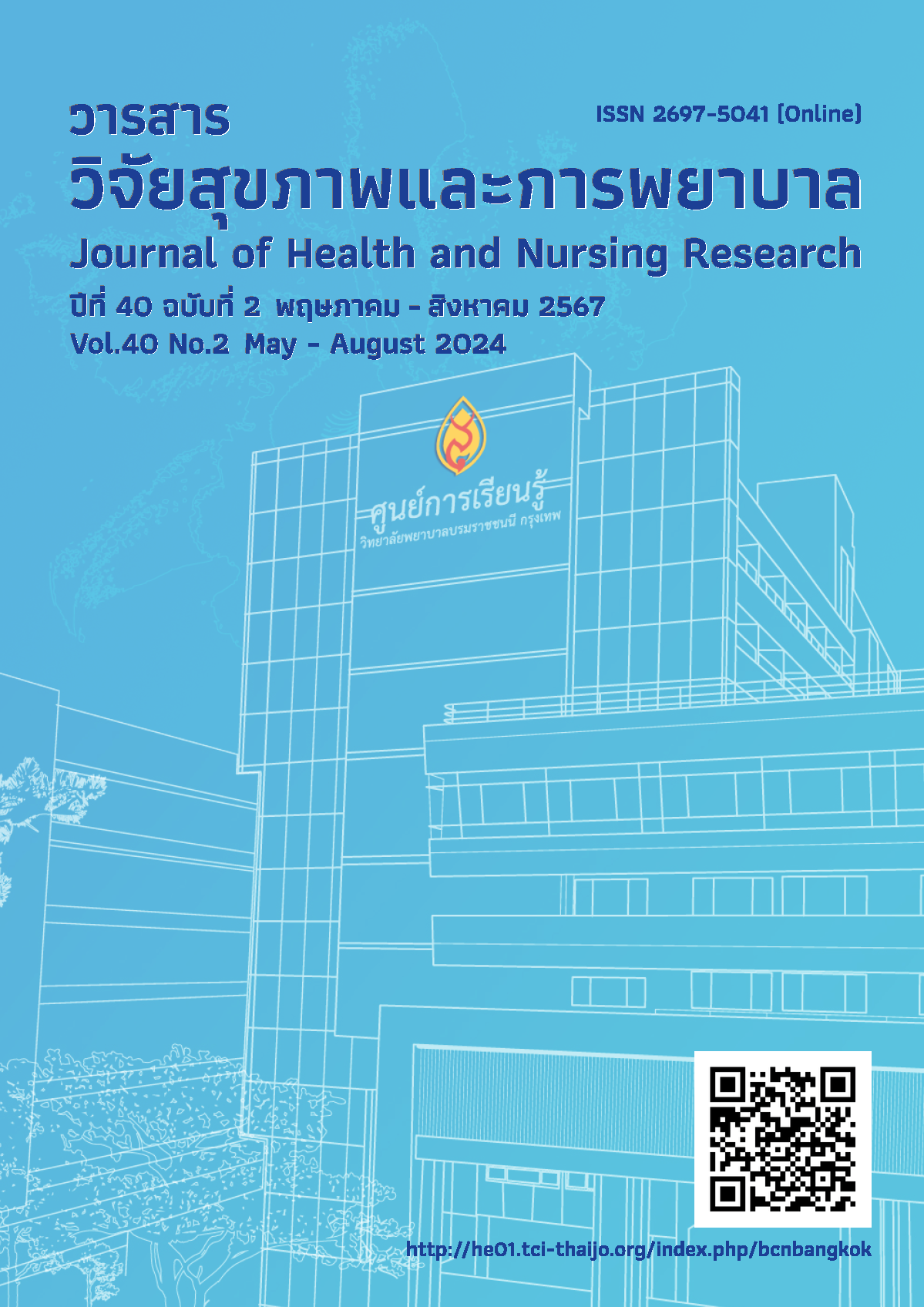ผลของโปรแกรมการป้องกันโรคตามแบบแผนความเชื่อด้านสุขภาพต่อพฤติกรรมสุขภาพ และระดับความดันโลหิตของพระสงฆ์กลุ่มเสี่ยงโรคความดันโลหิตสูง
คำสำคัญ:
โปรแกรมการป้องกันโรค , แบบแผนความเชื่อด้านสุขภาพ , พฤติกรรมสุขภาพพระสงฆ์ , กลุ่มเสี่ยงโรคความดันโลหิตสูงบทคัดย่อ
บทนำ: พระสงฆ์เป็นประชากรกลุ่มเสี่ยงหนึ่งที่กำลังเผชิญปัญหาโรคเรื้อรังและความดันโลหิตสูง เนื่องจากมีข้อจำกัดในการบริโภคหรือการฉันอาหาร การออกกำลังกาย และด้วยข้อจำกัดทางพระธรรมวินัย
วัตถุประสงค์การวิจัย: เพื่อศึกษาผลของโปรแกรมการป้องกันโรคตามแบบแผนความเชื่อด้านสุขภาพต่อการรับรู้ พฤติกรรมสุขภาพ และระดับความดันโลหิตของพระสงฆ์กลุ่มเสี่ยงโรคความดันโลหิตสูง
ระเบียบวิธีวิจัย: การศึกษานี้เป็นการวิจัยกึ่งทดลองแบบหนึ่งกลุ่ม วัดก่อนและหลัง กลุ่มตัวอย่าง คือ พระสงฆ์ กลุ่มเสี่ยงโรคความดันโลหิตสูง ที่จำพรรษาในเขตอำเภอโพนสวรรค์ จังหวัดนครพนม คัดเลือกแบบสุ่มอย่างง่าย เลือกตามคุณสมบัติของกลุ่มตัวอย่างที่กำหนด จำนวน 35 คน ระยะเวลาดำเนินการวิจัย 12 สัปดาห์ เครื่องมือที่ใช้ในการเก็บรวบรวมข้อมูล ได้แก่ แบบสอบถามข้อมูลส่วนบุคคล แบบสอบถามการรับรู้ตามแบบแผนความเชื่อด้านสุขภาพ และแบบสอบถามพฤติกรรมสุขภาพ เครื่องมือที่ใช้ในการทดลอง ได้แก่ โปรแกรมการป้องกันโรคตามแบบแผนความเชื่อด้านสุขภาพ วิเคราะห์ข้อมูลโดยใช้ค่าเฉลี่ย ร้อยละ ส่วนเบี่ยงเบนมาตรฐาน และสถิติ dependent t - test
ผลการวิจัย: พบว่าหลังเข้ารับโปรแกรมกลุ่มตัวอย่างมีค่าเฉลี่ยคะแนนการรับรู้ตามแบบแผนความเชื่อด้านสุขภาพและพฤติกรรมสุขภาพสูงกว่าก่อนเข้าร่วมโปรแกรมอย่างมีนัยสำคัญทางสถิติ (p < .001) และมีค่าเฉลี่ยระดับความดันโลหิตต่ำกว่าก่อนเข้าร่วมโปรแกรมอย่างมีนัยสำคัญทางสถิติ (p < .001)
สรุปผล: โปรแกรมช่วยทำให้การรับรู้ตามแบบแผนความเชื่อด้านสุขภาพ พฤติกรรมในการป้องกันโรคความดันโลหิตสูงในพระสงฆ์กลุ่มเสี่ยงดีขึ้น และส่งผลทำให้ระดับความดันโลหิตลดลง
ข้อเสนอแนะ: พยาบาลควรนำโปรแกรมนี้ไปใช้ในการปรับเปลี่ยนพฤติกรรมพระสงฆ์กลุ่มเสี่ยงและป่วยเป็นโรคความดันโลหิตสูงเพื่อลดระดับความดันโลหิต
Downloads
เอกสารอ้างอิง
World Health Organization. Noncommunicable diseases country profiles [Internet]. 2013 [cited 2022 May 12]. Available from: https://www.who.int/teams/noncommunicable-diseases/surveillance/data/profiles-ncd
Department of Disease Control, Ministry of Public Health. Statistics on the death rate from blood pressure disease high blood pressure in Thailand, 2016-2020 [Internet]. 2020 [cited 2022 Dec 25]. Available from: https://shorturl.asia/6EbaI. (in Thai)
Thai Public Health Survey Office. Report on the 6th survey of the health status of Thai people by physical examination. Bangkok: Ministry of Public Health; 2020. (in Thai)
Thai Hypertension Society. Thai guidelines on the treatment of hypertension [Internet]. 2019 [cited 2022 Dec 25]. Available from: https://shorturl.asia/8kCD4 (in Thai)
World Health Organization. A global brief on hypertension. Geneva: WHO; 2014.
Monks Hospital, Department of Medical Services. Annual report 2019 monks hospital. [Internet]. 2019 [cited 2022 Dec 25]. Available from: https://www.priest-hospital.go.th/pdf/2562/2562.pdf (in Thai)
Chobanian AV, Bakris GL, Black HR, Cushman WC, Green LA, Izzo Jr JL, et al. The seventh report of the joint national committee on prevention, detection, evaluation, and treatment of high blood pressure: the JNC 7 report. The Journal of the American Medical Association. 2003;289(19):2560-71.
Health Data Center. Information to respond to health status for group of monks and novices. [Internet]. 2022 [cited 2022 Oct 29]. Available from: https://shorturl.asia/qzQZ9
Tansakul C, Phumriew R, Rojanaviphat P. Self-care and food consumption behavior of the monks in Taweewattana district, Bangkok metropolis. [Internet]. 2018 [cited 2023 Feb 15]. Available from: https://shorturl.asia/v0NZ2
Ramanwong S, Subruangthong W, Sooksamran S. Promoting holistic health care of the monks in Lopburi. Rajapark Journal (Humanities and Social Sciences) 2018;12(25):94-95. (in Thai)
Tongterm T. Factor associated with physical activity among the elderly buddhist monks living in Sisaket province. Journal of MCU Nakhondhat 2019;6(9):4425-37. (in Thai)
Stretcher VJ, Rosenstock IM. The health belief model. In: Glanz K, Lewis FM, editor. Health behavior and health education: Theory, research, and practice. 2nd ed. San Francisco: Jossey-Bass; 1997.
Sanjorn W. Effectiveness of health education program applying theory health belief model to evaluate knowledge and prevention behaviors regarding stroke of hypertension patient Kantrang hospital Trang province [dissertation]. Trang: Sirindhorn College of Public Health Trang; 2019. (in Thai)
Loussug W, Lawang W, Homsin P. The effects of application of the health belief model with family support program on preventive behaviors against cerebrovascular disease among individual at risk. Journal of Nursing and Education 2019;12(4):32-45. (in Thai)
Faul F, Erdfelder E, Lang AG, Buchner A. G*power 3: a flexible sta-tistical power analysis program for the social, behavioral, and biomedical sciences. Behavior Research Methods 2007;39(2):175-191.
Cohen J. Statistical power analysis for the behavioral sciences. 2nd ed. New York: Lawrence Erlbaum Associates; 2013.
Sifa S. The study of health promoting behavior of monks in Pattani province. Academic Journal of Thailand National Sports University 2018;10(1):117-26.
Ngerndee K. The effectiveness of health belief application program for stroke prevention behavior among hypertensive patients at Muang district, Phayao province [Master’s thesis]. Phayao: Phayao University; 2021. Available from: http://www.updc.clm.up.ac.th//handle/123456789/1799 (in Thai)
Mheeaium P, Kanokthet T. Factors effect with health behavior of monk in Takhli district, Nakhonsawan province. Nakhon Lampang Buddhist Colleges Journal 2018;9(3):1-12. (in Thai)
ดาวน์โหลด
เผยแพร่แล้ว
รูปแบบการอ้างอิง
ฉบับ
ประเภทบทความ
สัญญาอนุญาต
ลิขสิทธิ์ (c) 2024 วารสารวิจัยสุขภาพและการพยาบาล (วารสารวิทยาลัยพยาบาลบรมราชชนนี กรุงเทพ)

อนุญาตภายใต้เงื่อนไข Creative Commons Attribution-NonCommercial 4.0 International License.
บทความที่ได้รับการตีพิมพ์ เป็นลิขสิทธิ์ของวารสารวิจัยสุขภาพและการพยาบาล (วิทยาลัยพยาบาลบรมราชชนนี กรุงเทพ) ไม่สามารถนำไปตีพิมพ์ซ้ำในวารสารฉบับอื่น


















